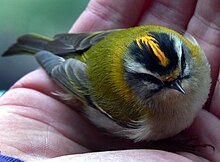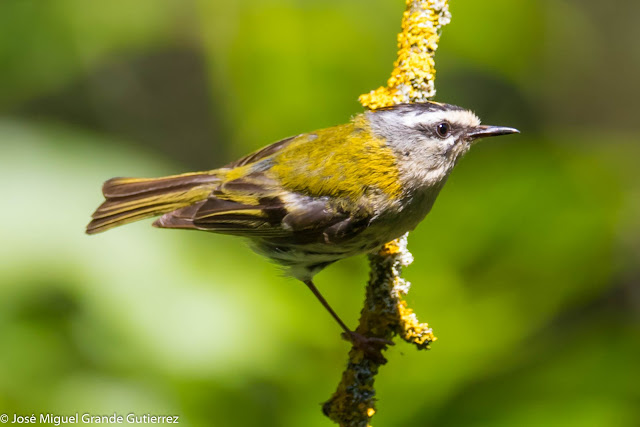The common firecrest (Regulus ignicapilla) also known as the firecrest, is a very small passerine bird in the kinglet family. It breeds in most of temperate Europe and northwestern Africa, and is partially migratory, with birds from central Europe wintering to the south and west of their breeding range. Firecrests in the Balearic Islands and north Africa are widely recognised as a separate subspecies, but the population on Madeira, previously also treated as a subspecies, is now treated as a distinct species, the Madeira firecrest, Regulus madeirensis. A fossil ancestor of the firecrest has been identified from a single wing bone.
This kinglet is greenish above and has whitish underparts. It has two white wingbars, a black eye stripe and a white supercilium. The head crest, orange in the male and yellow in the female, is displayed during breeding, and gives rise to the English and scientific names for the species. This bird superficially resembles the goldcrest, which largely shares its European range, but the firecrest's bronze shoulders and strong face pattern are distinctive. The song is a repetition of high thin notes, slightly lower-pitched than those of its relative.
The common firecrest breeds in broadleaved or coniferous woodland and gardens, building its compact, three-layered nest on a tree branch. Seven to twelve eggs are incubated by the female alone. Both parents feed the chicks, which fledge 22–24 days after hatching. This kinglet is constantly on the move and frequently hovers as it searches for insects to eat, and in winter it is often found with flocks of tits. Despite some possible local declines, the species is not the subject of significant conservation concerns owing to its large European population and an expansion of its range over the last century. It may be hunted and killed by birds of prey, and can carry parasites. It is possible that this species was the original "king of the birds" in European folklore.
Description[edit]
The common firecrest is a small plump bird, 9 cm (3.5 in) in length with a wingspan of 13–16 cm (5.1–6.3 in),[2] and weighs 4–7 grams (0.14–0.25 oz). It has bright olive-green upperparts with a bronze-coloured patch on each shoulder, and whitish underparts washed with brownish-grey on the breast and flanks. It has two white wingbars, a tiny black pointed bill, and brownish-black legs. The head pattern is striking, with a black eye stripe, long white supercilium, and a crest which is bright yellow in the female and mainly orange in the male. The sexes are very similar, apart from the crest colour, although the female is a little duller in plumage and on average slightly smaller. Juveniles have a grey tinge to the duller upperparts, and lack the coloured crown; the other head markings are present, but duller than in the adult. By their first winter, only the flight and tail feathers remainunmoulted, and the young birds are virtually indistinguishable from the adults in the field. This kinglet usually hops with its body held horizontally, and its flight is weak and whirring, with occasional quick evasive turns.[3]
Adult firecrests are unlikely to be confused with any other species; Pallas's warbler has a similar head and wing pattern, but its crown stripe is pale lemon, not bright yellow or orange, and its supercilium is also pale yellow, not bright white. The juvenile common firecrest might be confused with the goldcrest, but usually shows enough face pattern to distinguish it from its relative, which has a very plain face at all ages.[3] The firecrest can also be separated from Pallas's warbler by the warbler's pale crown stripe and yellow rump. There is more likelihood of confusing the juvenile firecrest with the yellow-browed warbler, which has a similar head pattern; the warbler (an Asiatic species) has pale fringes to the feathers of the closed wing, a whitish belly and darker brown legs. The yellow-browed warbler also lacks the pale half circle present below the young firecrest's eye.[4]
Taxonomy and systematics[edit]
The kinglets are a small group of birds sometimes included in the Old World warblers, but frequently given family status,[5] especially as recent research shows that, despite superficial similarities, the crests arephylogenetically remote from the warblers.[6][7][8] The names of the family, Regulidae, and its only genus, Regulus, are derived from the Latin regulus, a diminutive of rex, "a king",[9] and refer to the characteristic orange or yellow crests of adult kinglets. The common firecrest was first formally described by Dutch zoologist Coenraad Jacob Temminck in 1820 as Sylvia ignicapilla;[10] the relatively late identification of this common European bird arose from a perception that it was just a variety of the goldcrest.[11] The species name is derived from Latin ignis "fire" and capillus "hair".[9] The binomial is frequently given as R. ignicapillus due to a misunderstanding of Latin grammar.[12]
There are two widely recognised subspecies of common firecrest, nominate R. i. ignicapilla and Mediterranean R. i. balearicus (Jordans, 1923). The latter form is found on the Balearic Islands and in north Africa, and is slightly paler below and greyer above than the nominate subspecies.[3] Other subspecies have been claimed, including southeastern R. i. caucasicus, North African R. i. laeneni,[13] and Crimean R. i. tauricus.[14] The Madeira firecrest,R. madeirensis, was formerly also considered to be a subspecies of the common firecrest, but phylogenetic analysis based on the cytochrome b gene showed that the Madeiran form is distinct at the species level. Cytochromeb gene divergence between the Madeira firecrest and the European bird is 8.5%, comparable with the divergence level between other recognised Regulus species, such as the 9% between the goldcrest and the golden-crowned kinglet.[15] The island form also differs in morphology and vocalisations.[16] The proposed split was accepted by the Association of European Rarities Committees (AERC) in 2003,[17] although some authorities, like The Clements checklist, have not yet recognised the new species.[18]
The flamecrest or Taiwan firecrest (Regulus goodfellowi) of Taiwan has sometimes been viewed as a race of the common firecrest; however, the flamecrest's territorial song, which resembles those of the Himalayan races of the goldcrest, and genetic data indicate that the flamecrest is closely related to the Himalayan goldcrest and only distantly to the two firecrest species.[19] The kinglets on the Canary Islands, which were also considered to be close to firecrests, have now been shown to comprise two subspecies of goldcrest.[20]
El reyezuelo listado2 (Regulus ignicapilla)3 es un ave muy pequeña perteneciente a la familia Regulidae. Se reproduce en la mayoría de las zonas templadas de Europa y del norte de África. Es parcialmentemigratoria, con las aves del norte y el este invernando al sur del área de reproducción. En invierno se encuentra a menudo en bandadas con otras aves.
Esta es la segunda ave más pequeña europea midiendo de 9 a 10 cm. Es de color verdoso por arriba con el vientre blanquecino. Tiene dos bandas en las alas blancas, un lista por el ojo negra y una franja superciliarblanca. Posee una cresta, de color naranja en el macho y amarilla en la hembra, que se muestra durante la época de cría. Esta es una especie inquieta, constantemente en movimiento, ya que busca los insectos, y se cierne con frecuencia. Se asemeja al reyezuelo sencillo, pero sus hombros color bronce y el patrón de la cara son distintivos.
El reyezuelo de Madeira, previamente tratada como una especie aparte R. madeirensis aunque ahora se trata como una subespecie distinta R. i. madeirensis,3 tiene una línea superciliar más corta, más apagado el naranja de la cresta y un pico ligeramente más largo.











No hay comentarios:
Publicar un comentario